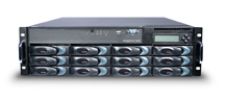
An image Grid is a PACS appliance designed to simplify image management, storage and archive capabilities and requires less administration. Image courtesy of Candelis.
While the debate over single versus multidepartment archives continues, there are important considerations for facilities planning to implement or expand an information technology (IT) infrastructure. According to Scott Cleare, SMB infrastructure sales manager, IBM Healthcare and Life Sciences, facilities must evaluate their infrastructure and examine the reasons for change. “Often within healthcare, a change in infrastructure or equipment is the result of some event,” indicated Cleare.
A key consideration is to examine the change and determine how that will impact the facility’s requirements for transporting and sharing information in the present and future. This includes the type of modalities, the pool of authorized users, dissemination of study data, IT or system management and support staff and financial requirements.
“Challenging the conventional wisdom behind implementing multidepartmental archiving strategies is the concept of PACS appliance archiving specifically dedicated to those imaging practices and hospital departments that utilize high-resolution imaging modalities, such as multidetector CTs, 64-slice cardiac CTs, MRIs and digital ultrasounds,” said Hossein Pourmand, vice president of Business Development, Candelis Inc. “While certain modalities may require cross-departmental access to clinical images, sharing data over a single network may become too time-consuming and challenging for even the most robust network infrastructures.” Pourmand notes that today’s 64-slice CTs are averaging one to two gigabytes per study and, in the future, 256-slice CTs will produce two to 10 times the images study size.
Not all facilities require a central repository for all images, concurs David DiNoia, vice president, Professional Services, InSite One. “Sites implement flexible rules to control permission and security to images and data,” said DiNoia. Based upon these rules, facilities can also implement multiple archives. However, DiNoia notes this does not imply that data cannot be shared when required. “As long as data is stored on an open system archive following industry standards such as DICOM or XDS and not wrapped in a proprietary storage ‘algorithm,’ then that data can be shared even with different types of storage devices and vendors.”
By following standards, facilities can also move from a single to multi-department archive strategy. Cleare added, “The choice will be based on the facility’s financial requirements. We recommend starting with one department in a cost-constrained environment and then move forward as funding allows by initially laying the foundation for the enterprise infrastructure.” This includes a thorough evaluation of the “state of the environment,” said Cleare, including determining which applications are storing images and where those images are needed, the type and speed of the network, the types of storage devices that may already be directly connected to a modality or a PACS and the server environment.
Pool Of Users
Another key issue is the pool of users and where they reside. For example, an imaging center would not send the images to referring physicians; rather the facility would provide permission (i.e., user ID and password) for viewing patient images. DiNoia cites a client example of a leading radiology group practice that owns several imaging centers and provides reading services to the local health system. These competing entities – the practice and the health system – own their own separate PACS and archive. Site services can allow users to share patient data to provide optimal patient care, regardless of where the imaging study was conducted, without providing permission or access to each other’s PACS.
Less Overhead is More
Prohibitive prices, system complexity and management and/or administration overhead associated with implementing multidepartmental archiving may also limit a sites archive solution choices, says Pourmand. An image Grid is a PACS appliance designed to simplify image management, storage and archive capabilities and requires less administration.
According to Cleare, IBM’s SAN Volume Controller (SVC) also simplifies IT infrastructure by combining storage capacity from multiple vendors into a single reservoir of capacity that can be managed from a central point. Application servers simply write information to the SVC, which then manages all of the attached storage and simplifies administration and improves disk utilization across the enterprise.
Environmental Factors for ROI
Additional considerations should always include information life cycle management, total cost of ownership and return on investment. “In a smaller hospital or clinic that does not have a sophisticated IT group or doesn’t generate a lot of studies, it can be appropriate to have a centralized or single department archive,” Cleare said.
“We ask facilities if there is a common viewing platform or application for information, such as an EMR, and where they are at on the spectrum of implementing the EMR,” Cleare said. Hospitals should understand the IT environment, their facility’s healthcare goals and enterprise strategy prior to implementing any archive strategy.
A complete list of these vendors and their solutions can be found at www.ITNonline.net in the Archive/Storage and Storage Management Comparison Chart.


 June 28, 2024
June 28, 2024 









